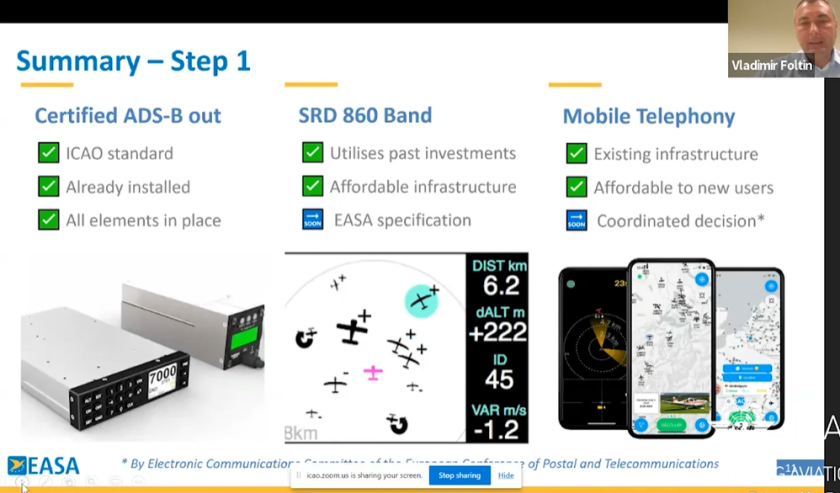By Jenny Beechener
“Mobile telephony is the answer to aircraft conspicuity – with conditions,” said Vladimir Foltin, European Aviation Safety Agency (EASA) Certification Manager and ATM Expert at the Drone Enable webinar hosted by ICAO on 14 September 2022. He said mobile telephony uses existing infrastructure and is affordable to new users. “Although aerial use is not explicitly forbidden, neither is it explicitly legal. Therefore, it still needs to be legalised by telephone coordinators and their regional regulators.” Similarly, roaming services do not extend to aerial mobility, therefore these services and frequencies need to be standardised. European telecommunications regulators are working on these issues and EASA expects a coordinated decision “in the coming months, latest within a year”.
EASA is working hard to put in place its own standards for Electronic Conspicuity (E-Conspicuity) – an essential technology for reducing mid-air collisions. According to European Chair of the International pilot’s association IAOPA Michael Erb, aviators need to transition from “see and avoid” to “sense and avoid” to enable uncrewed vehicles to share the same airspace as manned aviation. Mid-air collisions are already “unacceptably high”, with 137 fatalities between 2009 and 2019 recorded by EASA, all in uncontrolled airspace. “The risk would drastically increase if small, almost invisible to human eye, Uncrewed Aerial Systems (UAS) enter the airspace in high numbers”.
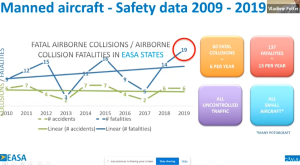
Vladimir Foltin identified four principal reasons: Ineffective sharing of traffic information; congestion in uncontrolled airspace; airspace inefficiencies; and looking ahead, increased drone operations. For these reasons, EASA proposes AMC/GM SERA.6005(c) regulation that requires all manned aircraft, not subject to air traffic control, to make themselves continuously electronically conspicuous to the U-space service providers. Fully aligned with the development of U-space in Europe, the proposal is currently out for consultation and comment, and EASA expects the regulation to be ready by the end of 2022. This represents the first step towards achieving E-Conspicuity, which “only goes as far as to ensure the pilot can be seen”. EASA anticipates further steps to reach in-flight electronic Conspicuity Plus (iConspicuity) where information also broadcasts flight information services and “enables USSPs to see manned aircraft and remove hazards flying in the space airspace”.
The EASA AMC/GM SERA.6005(c) proposed regulatory requirement aims to be affordable and provide minimum necessary real-time position information so that U-space service providers (USSPs) can safety separate airspace users. It aims to use existing and open standards wherever possible, operate within the ITU regulated spectrum, achieve pan-European applicability, and suit urban and low-level airspace (a challenging environment for Mode S datalink). EASA’s vision extends beyond Europe’s single compliant technology, Automatic Dependent Surveillance – Broadcast (ADS-B), to overcome some of these requirements. For example, ADS-Light (ADS-L) offers a Europe-wide coordinated spectrum already in use, with several manufacturers preparing to support this service in non-aviation spectrum (SRD-860). “We are finalising this specification. A draft has been circulated and commented on. we should be ready in a few weeks,” said Vladimir Foltin.
Longer term, EASA proposes ADS-L using mobile telephony. Researching smartphones versus dedicated devices, EASA favours affordable smartphones with an application to make aircraft conspicuous in U-space airspace when it is the only application running. This is dependent upon a coordinated decision by the Electronic Communications Committee of the European Conference of Postal and Telecommunications.
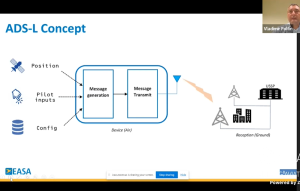
IAOPA meanwhile identifies additional candidate technologies to support E-Conspicuity. “98% of gliders use FLARM,” said Michael Erb. “It is low cost, low power, but low range and works outside the aviation spectrum so it does not work for everybody.” He points to Garmin as a more advanced system used by general aviation, and Skydemon applications already used in the cockpit on smartphones and tablets. Existing proven solutions such as TCAS and ADS-B based on Mode S tend to be unaffordable for general aviation and can be subject to frequency congestion. “We need to develop technical enablers and integrate them into one system,” he said.
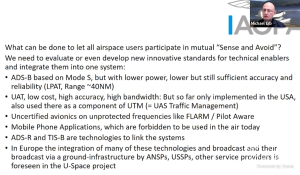
The US general aviation community already invests in UAT (987 MHz); securing low cost, high accuracy, high bandwidth datalink, and the technology is designated a component of the future UAS Traffic Management (UTM) environment, said Michael Erb. UAT also capable of uplinking weather and UAS information, and although not widely used in Europe, recent large-scale trials in the UK brought positive results. “Integration and broadcast via ground infrastructure is foreseen in European U-space project research,” he added. “Currently, we face a complex array of multiple links connecting conventional, military, low and high-flying vehicles.”
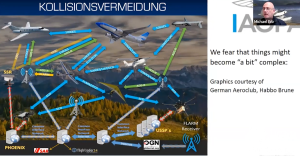
Presenting a UAS operator perspective, Matthew Satterley, head of Policy and Government Relations at Wing, is excited about the onset of E-Conspicuity measures “bringing predictability and clarity about how and where we can grow our operations. We view E-Conspicuity as a major advancement in airspace access for the UAS industry.” Wing’s existing delivery services in urban areas rely on manual coordination with air traffic control and local flying clubs. “We have been operating since 2017 with zero mid-air collisions, accidents or incidents with as many as a thousand daily operations at urban sites in Australia.” The vehicles are equipped with ADS-B IN capability to detect and avoid traditional aircraft, but the company cannot scale up without “a more cooperative and collaborative airspace system”.
Altitude Angel Implementation Manager George Standford agrees: “The industry still has a way to go to unlock large-scale beyond visual line of sight (BVLOS) operations. How do you mitigate for non-electronic conspicuity drones? ADS-B is not mandatory for general aviation, does not guarantee 360deg coverage, and is prone to blockage. E-Conspicuity is essential technology for UTM, but until 100% coverage can be guaranteed, it remains only part of the solution, not the solution in its entirety.”
For more information visit:
https://www.icao.int/Meetings/DRONEENABLE2022/Pages/default.aspx



